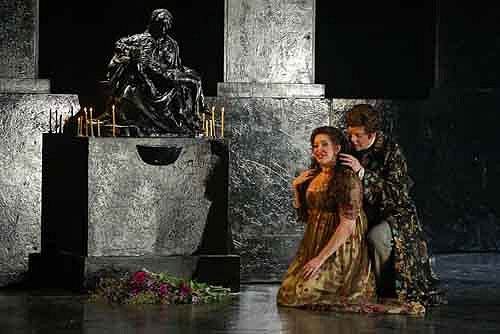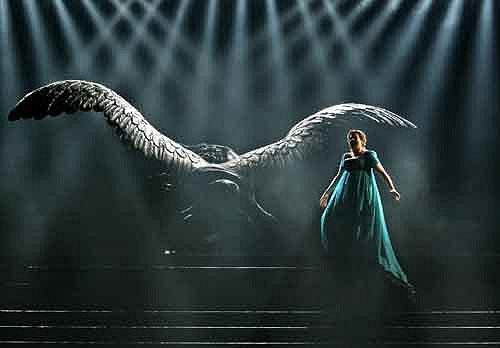S & H Opera Review
Giacomo Puccini, Tosca, soloists, English National Opera, Noel Davies, London Coliseum, March 16th, 2004 (CC)
The shabby little shocker certainly pulls in the crowds. And deservedly so, for above and beyond the perhaps more obvious attractions of torture, murder and unbridled lust what strikes the listener is Puccini’s sheer dramatic genius. The musical realisation of plot is well-nigh perfect in its pacing, certainly when as carefully presented as here under the direction of Noel Davies.
In particular, Davies commendably seemed intent on revealing the modernist elements of the score right from the beginning - this was not to be a comfortable experience, an impression confirmed by the predominantly black stage of Act 1, dominated by an oppressive, massive, slanting cross that looms over all.
Julian Gavin took the part of Mario Cavaradossi. His is not a big voice, and his ‘Recondita armonia’ was thin of tone. Perhaps he was not helped by his vocal surroundings, a focussed Angelotti and a Sacristan (Graeme Danby) whose asides were perfectly timed. Gavin’s legato did not improve for the bigger scenes with Tosca, breath control in general seeming to be the problem. Sitting in the stalls, at least everything he did was audible, but there was the recurring thought that surely he could not be projecting up into the Gods? The same thought returned strongly in the final act at ‘E lucevan le stelle’ (‘I remember the evening’), although here he managed to rise well to the climax.
Tosca was Claire Rutter (who from a distance bears a disconcerting likeness to Cecilia Bartoli). She appeared not to be on top form, her vibrato warbly, her Act 2 cry of ‘Assassino!’ (rendered, unsurprisingly, as ‘Assassin!’) carrying little force, and her final gesture of the opera was more a half-scream than anything else. She fell well, though, and her ‘Visi d’arte’ (‘Life was music’) tended towards the touching. Her best moment came as she asked Scarpia, ‘How much? Your price…’. At this point she approached some sort of the Mediterranean underlying strength of defiance that Tosca so clearly should possess.
But it was the Scarpia who stole the show and convinced one that, despite all the evidence (arias) to the contrary, this devil gets all the good tunes. Right from ‘Tosca è un buon falco!’ (‘Tosca’s my falcon’) it was clear we were in the presence of a big, forceful, confident and above all intrinsically malevolent personality. It was Bleiker’s presence, accentuated by Ian Jackson-French’s atmospheric lighting, that made Act II the sexual thriller it needs to be – a pity Tosca’s murder of Scarpia was garbled (words and whole phrases disappeared) and, of course, the English word ‘Die’ does not carry the expressive force of the Italian ‘Muori!’.
The spurious kiss she plants on Scarpia’s corpse that caused so much critical comment when the production was first unveiled was there. This nod towards the shadowy world of necrophilia seemed strangely convincing to this reviewer in context – love and hate are not that far removed after all (some would say they are opposite sides of the same coin), and in a scene where emotions are as foregrounded as here, the gesture made horrifying, shocking sense.
The orchestra seemed fully responsive and involved throughout. Horns at the beginning of Act 3 were a distinct improvement on the Rhinegold I heard recently (although some exposed ‘cello lines left room for doubts to creep in).
Diction from the soloists was generally acceptable, but there were some decidedly shaky moments. ‘Get me my palette’ came across rather unfortunately as ‘Get me my parrot’, for example. The translation holds out well, though, despite the fact that there is an evident and unavoidable loss of expression (even a simple line like ‘Ecco la chiave’ loses its expressive contour when we hear the smoother, ‘Here is the key’).
It takes a lot to take the force out of Tosca, and whatever the various failings of this evening, the shocker emerged intact.
Colin Clarke
Claire Rutter (Tosca) & Julian Gavin (Cavaradossi)
Claire Rutter (Tosca)
Photographer, Clive Barda.


 Return to:
Return to: